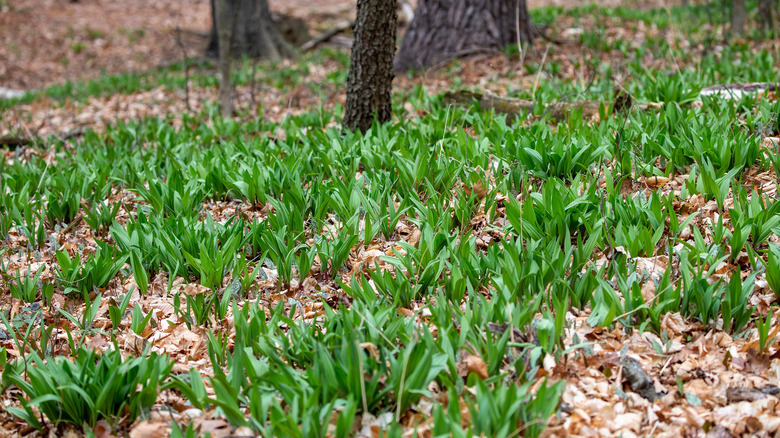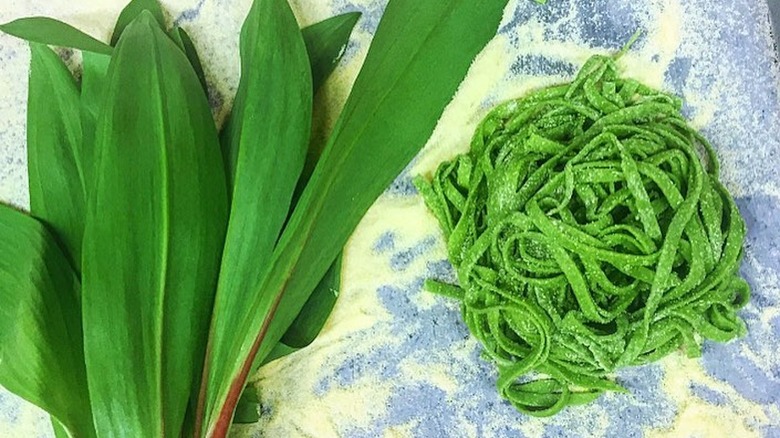Everything You Need To Know About Sustainably Foraging Ramps
Touted as a seasonal culinary delicacy, the sometimes elusive ramp (Allium tricoccum) begins sprouting up through the forest floor during the cool days of early spring, per Serious Eats. This vernal wild edible boasts a uniquely prominent garlic flavor reminiscent of leeks and scallions but notably more pungent; it's an acquired taste. Hailing from the Amaryllidaceae family, along with other plants like lilies and shallots, this perennial bulb produces an edible stalk and leaves highly coveted by chefs, foragers, and foodies alike.
Ramps, aka wild onions, are only available during a short window of time and are difficult to cultivate, making them a much sought-after veggie that has been foraged to the point of endangerment in some areas. Demand for ramps has grown as their distinct flavor and short-lived appearance on menus have piqued patrons' curiosity and taste buds. As foraging becomes trendy and novices take to the forest to find a patch of ramps in the wild, the plant is increasingly threatened by incorrect and damaging harvesting techniques.
Identifying ramps in the wild
If you're hunting for ramps in the wild, Wisconsin Horticulture suggests searching the rich, mulchy floor of a deciduous forest. Ramps are native to eastern North America, sprouting under the leaves of poplar, birch, hickory, and oak tree forests that cover areas from Quebec, Canada, down to South Carolina, and as far west as Minnesota. They notoriously thrive in the Appalachian region of the United States.
The bulb of this herbaceous plant resembles that of a scallion but has a reddish tinge around the stalk. Unlike the hollow, narrow leaves of green onion, ramp leaves grow broad and flat like those of a tulip. They are differentiated from other similar-looking plants by the garlicky scent released when cut or torn. Ramps grow in colonies and prefer to take root in medium wet, richly organic soil in shady areas.
According to the USDA Forest Service, ramps lie dormant from October to early spring, with shoots emerging in late March and leaves developing through the end of May. The leaves die back in early summer, and the plant grows small white flowers that eventually produce round black seeds after pollination. It can take up to 18 months for seeds to germinate and seven years for plants to grow large enough to harvest. This lengthy growth period makes it all the more important to forage for ramps responsibly.
Tips on sustainably foraging for ramps
If you've decided to venture out into the forest and forage for ramps, Wild Edible has some hot tips to help you harvest responsibly. You'll want to start by checking with your local forest service to see if there are any regulations on acceptable harvest areas and methods or restrictions on the amount of ramps you can gather. Pack a sharp knife, and be sure to bring a bag to collect your wild goodies.
When you come upon a patch of greenery, make sure you have discovered ramps and not the very similar but highly toxic Lily of the Valley. A Magical Childhood recommends comparing the appearance, location, and scent of the two plants. Lily of the Valley has no bulb, usually grows outside of the forest canopy, and is missing the tell-tale onion scent of the ramp. Junior varsity foragers should utilize reference materials or consult an experienced forager to confirm the species of a wild plant before consumption.
To harvest a ramp sustainably, foragers should cut one edible leaf from the plant and leave the second leaf and bulb intact. If more of the plant is desired, one should carefully dig into the dirt and slice through the bulb a third of the way down, leaving the bottom of the bulb and roots intact. Serious Eats recommends harvesting plants at the center of the ramp colony so the patch can stay strong and continue to grow.
Why sustainable ramp harvesting is important
According to Serious Eats, ramps have long been considered the first vegetable of spring for many Native Americans and forest animals in the Appalachian region. After enduring long, cold winters, the piquant leaves and bulbs of the ramp were a welcome treat for many indigenous people who still forage for the wild onions today.
According to the USDA Forest Service, as ramps gained popularity, people began hosting ramp festivals, featuring the veggie on seasonal menus at restaurants, and taking to the forest to forage for themselves. Novice gatherers often pulled ramps out of the ground from the root and harvested entire patches that were more than they could use or sell. These incorrect practices endangered many established ramp colonies.
Foraging is an age-old practice that has sustained populations throughout history, and one of its central tenets is the restoration of the land and plants that produce a harvest. By taking no more than what is needed, foragers can maintain the bounty of wild edibles while respecting the ecosystems, animals, and cultures of people they sustain.
Cooking with ramps
You've done your due diligence by foraging for ramps sustainably, and now it's time to enjoy the fruits (or vegetables) of your labor. Described by Food & Wine as the "holy grail of spring produce," the ramp embodies the foundational flavors of garlic and onion balanced with a hint of sweetness.
Ramp aficionados suggest simply grilling ramps to enjoy their naturally delicious flavor with other vegetables or as a spicy-sweet bruschetta-style topping. They complement egg dishes, like quiche, and lend their intensely piquant flavor to mild cheeses.
Like most fresh produce, ramps deteriorate quickly, but their flavor can be preserved and enjoyed over time by pickling them or making ramp compound butter. Ramps make an ideal seasonal substitute for shallots in traditional vinaigrettes and are a tasty garnish for a lackluster salad. Forget the leeks in your vichyssoise, and go for the robust flavor of ramps instead. Ramp pesto is a versatile condiment that pairs well with seafood and imparts a fresh pop of flavor to pasta dishes.
It seems that there is no wrong way to ramp. Their seasonal availability and distinct flavor notes make them the darling of spring, and by foraging for ramps sustainably, they can be a wild delicacy enjoyed by generations to come.




